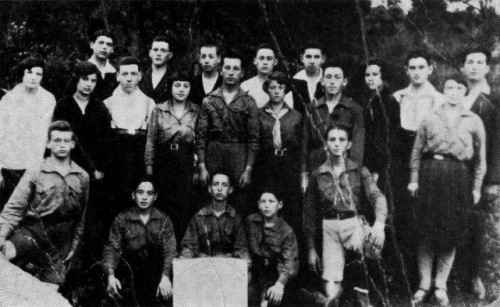 |
|
|
[Page 112]
by Pepe Ravid-Klugman
Translated by Yocheved Klausner
Although a long time has passed since I left my old home and have settled and built a home in Israel, our little town Lesko has not left my memory. It stands vividly in front of my eyes: here is the wide “Rink” (the center) with the beautiful City Hall building; here are the wooden sheds housing the little shops and stands where all the trading and bargaining was taking place continuously. The competition between the stand-owners was great, each trying to persuade the peasant-buyer that his ware was the best. Those who succeeded to make a good sale and could bring home food for their family were satisfied and happy.
|
|
| Hashomer Hatzair branch in 1937 |
I can see the big well in the center of town; the water-carriers used it to supply water to the population. In my mind I see the hidden narrow alleys, the resplendent “Big Synagogue,” the Batei Midrash (lit. “houses of learning”) and the two Kloiz synagogues. In all these institutions Jewish life flowed vibrantly, with its lights and shadows. The various figures appear before me as well: the “respected” Jews and the notables, and at their side the simple Jews – amcha – hurrying all day long to earn their daily bread. There was also the “intelligentsia,” the Torah scholars, the “enlightened” who sought to gain education and knowledge, and also the “town's fools” just like in any other town.
[Page 113]
|
|
| Farewell party for Moshe and Chana Schwartz, in honor of their Aliya to Eretz Israel |
|
|
| “The Laboring Eretz Israel” |
However, undoubtedly the high point of Jewish life in town was the organization of Zionist parties and youth movements: Hashomer Hatzair, Hanoar Hatzioni, Poalei Zion, Freiheit, Mizrahi and the General Zionists. The activity of Hashomer Hatzair among the youth in town was extensive in particular.
[Page 114]
During the long winter nights the young people would gather in the large halls of the local movement branches and conduct cultural, educational and publicity activities. During summer, they would fill the forests, mountains and other beautiful spots in the surrounding area and enjoy nature. From time to time, Hebrew and Yiddish songs would be heard and spontaneous hora dancing would sometimes continue until the late hours of the evening. Emissaries from Eretz Israel visited the town and helped organize the activities.
No wonder, then, that so many of these youths realized their aspirations and made Aliya to Eretz Israel. They went there by several roads – some succeeded in obtaining “certificates” from the British authorities, some came on the “illegal Aliya.” I made Aliya in 1943 and joined my brother on the kibbutz Mishmar Ha'emek.
|
|
| A Hashomer Hatzair group, working in a sawmill |
Since my parents lost a son in Eretz Israel in 1927, I promised them to visit as soon as possible. In 1937 I fulfilled my promise and went to visit my old home. I was supposed to stay six months, but I remained an entire year. My parents were very happy, but I, who was already accustomed to another way of life, found it difficult to adjust. The youth movements were still partly active, but unfortunately the former Zionist-pioneering spirit was gone. The young people have changed, and the desire to go to Eretz Israel was not as strong as before; it has become almost irrelevant. Perhaps the reason was the Arab riots [“The Arab Revolt”] in Eretz Israel.
The only aspiration and hope of the young men and women in town was to have “a good life” and quiet times. The Culture Hall was turned into a ”Club” where people danced and played cards. One would never have imagined that the same hall had witnessed, in the past, an entirely different life, vibrant and full of hope. I felt sorrow seeing all this.
[Page 115]
I think that any person, who had experienced the Arab riots in our country and visited the old town, would feel the same. Here, in Eretz Israel, he was witness to a feeling of full devotion and self sacrifice on the part of the young people, and there – indifference and resignation. The situation hurt even more when I realized that none of the town's Jews could think that in a short time the Holocaust would erase all Jewish life in Lesko, as in all towns in Eastern Europe.
|
|
| Poalei Zion - 1932 |
|
|
| Hashomer Hatzair Drama Group |
|
|
JewishGen, Inc. makes no representations regarding the accuracy of
the translation. The reader may wish to refer to the original material
for verification.
JewishGen is not responsible for inaccuracies or omissions in the original work and cannot rewrite or edit the text to correct inaccuracies and/or omissions.
Our mission is to produce a translation of the original work and we cannot verify the accuracy of statements or alter facts cited.
 Lesko, Poland
Lesko, Poland
 Yizkor Book Project
Yizkor Book Project
 JewishGen Home Page
JewishGen Home Page
Copyright © 1999-2025 by JewishGen, Inc.
Updated 06 Mar 2017 by JH